Paper Menu >>
Journal Menu >>
 Journal of Minerals & Materials Characterization & Engineering, Vol. 9, No.1, pp.43-55, 2010 jmmce.org Printed in the USA. All rights reserved 43 Studies on Al6061-SiC and Al7075-Al2O3 Metal Matrix Composites G. B. Veeresh Kumar1*, C. S. P. Rao2, N. Selvaraj2, M. S. Bhagyashekar3 1Research Scholar, National Institute of Technology, Warangal, (A.P), India & Department of Mechanical Engineering, S B M Jain College of Engineering, Jain University, Jakkasandra (P), Kanakapura (T), Ramanagara (D)-562 112, Karnataka, India. 2Department of Mechanical Engineering, National Institute of Technology, Warangal, (A.P), India. 3Department of Mechanical Engineering, Don Bosco Institute of Technology, Bangalore, Karnataka, India. *Corresponding author: veeru232@yahoo.com ABSTRACT The aluminum based composites are increasingly being used in the transport, aerospace, marine, automobile and mineral processing industries, owing to their improved strength, stiffness and wear resistance properties. The widely used reinforcing materials for these composites are silicon carbide, aluminum oxide and graphite in the form of particles or whiskers. The ceramic particles reinforced aluminum composites are termed as new generation material and these can be tailored and engineered with specific required properties for specific application requirements. Particle reinforced composites have a better plastic forming capability than that of the whisker or fiber reinforced ones, and thus they have emerged as most sought after material with cost advantage and they are also known for excellent heat and wear resistance applications. In this paper it is aimed to present the experimental results of the studies conducted regarding hardness, tensile strength and wear resistance properties of Al6061-SiC and Al7075-Al2O3 composites. The composites are prepared using the liquid metallurgy technique, in which 2-6 wt. %’age of particulates were dispersed in the base mat rix in st eps of 2. The obtained cast composites of Al6061-SiC and Al7075-Al2O3 and the castings of the base alloys were carefully machined to prepare the test specimens for density, hardness, mechanical, tribological tests and as well as for microstructural studies as per ASTM standards. The SiC and Al2O3 resulted in improving the hardness and density of their respective composites. Further, the increased %’age of these reinforcements contributed in increased hardness and density of the composites. The microphotographs of the composites studied revealed the uniform distribution of  44 G. B. Veeresh Kumar, C. S. P. Rao, N. Selvaraj, M. S. Bhagyashekar Vol.9, No.1 the particles in the matrix system. The experimental density values were agreed with that of the theoretical density values of the composites obtained using the rule of mixture for composites. The dispersed SiC in Al6061 alloy and Al2O3 in Al7075 alloy contributed in enhancing the tensile strength of the composites. The wear factor K obtained using computerized pin on disc wear tester with counter surface as EN31 steel disc (HRC60) and the composite pin as specimens, demonstrated the superior wear resistance property of the composites. Key words: Al6061-SiC, Al7075-Al2O3, Metal Matrix Composites, Density, M icrostructure, Hardness, Mechanical properties, Wear Factor. 1. INTRODUCTION Aluminum alloys are preferred engineering material for automobile, aerospace and mineral processing industries for various high performing components that are being used for varieties of applications owing to their lower weight, excellent thermal conductivity properties. Among several series of aluminum alloys, heat treatable Al6061 and Al7075 are much explored, among them Al6061 alloy are highly corrosion resistant and are of excellent extricable in nature and exhibits moderate strength and finds much applications in the fields of construction (building and high way), automotive and marine applications. Aluminum alloy 7075 possesses very high strength, higher toughness and are preferred in aerospace and automobile sector [1]. The composites formed out of aluminum alloys are of wide interest owing to their high strength, fracture toughness, wear resistance and stiffness. Further these composites are of superior in nature for elevated temperature application when reinforced with ceramic particle [2]. The literature survey regarding the above alloy systems and their composites are as follows. G. Straffelini et.al. [3] reported that the matrix hardness has a strong influence on the dry sliding wear behavior of Al6061-Al2O3 composites. A. Martin et. al. [4] in the studies of tribological behavior on Al6061-Al2O3 composites concluded that a characteristic physical mechanism involves during the wear process. S.Y. Yu et. al. [5] demonstrated the effects of applied load and temperature on the dry sliding wear behavior of Al6061-SiC composites and concluded that the wear rate decreases with increased applied load. H.C. How and T.N. Baker [6], in their investigation of wear behavior of Al6061-saffil fiber, concluded that saffil are significant in improving wear resistance of the composite. Liang Y. N. et. al. [7] reported that the MMCs containing SiC particles exhibit improved wear resistance. Basavarajappa S., et. al. [8] stated that the microstructural characteristics, applied load, sliding speed and sliding distance affect the dry sliding wear and friction of MMCs. However, they conclude that, at higher normal loads (60N), severe wear and silicon carbide particles cracking and seizure of the composites occurs during dry sliding. Chandramohan G., et. al. [9] reported that the sliding distance has the highest effect on the dry sliding wear behaviour of MMCs than that of the load and sliding speed. Y. Reda et. 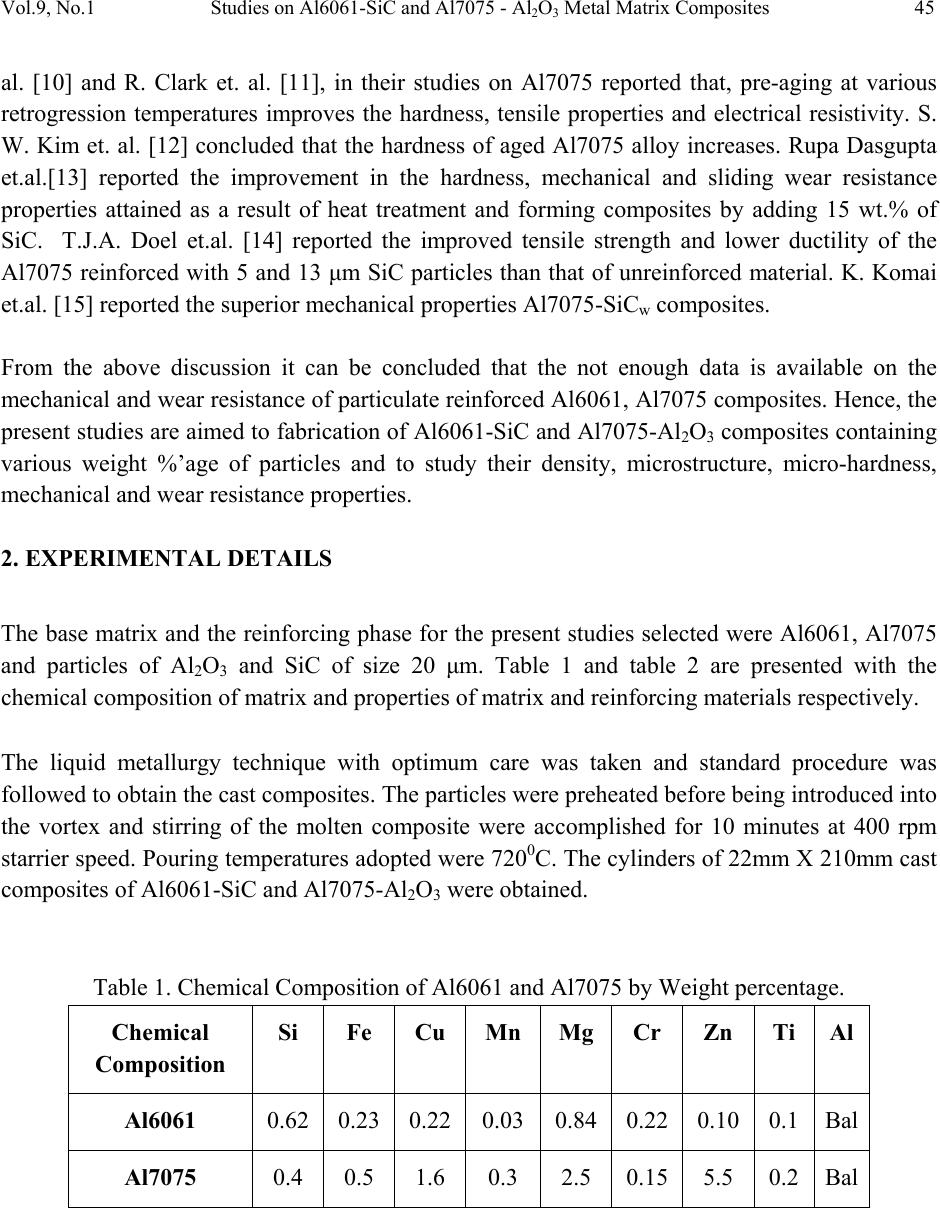 Vol.9, No.1 Studies on Al6061-SiC and Al7075 - Al2O3 Metal Matrix Composites 45 al. [10] and R. Clark et. al. [11], in their studies on Al7075 reported that, pre-aging at various retrogression temperatures improves the hardness, tensile properties and electrical resistivity. S. W. Kim et. al. [12] concluded that the hardness of aged Al7075 alloy increases. Rupa Dasgupta et.al.[13] reported the improvement in the hardness, mechanical and sliding wear resistance properties attained as a result of heat treatment and forming composites by adding 15 wt.% of SiC. T.J.A. Doel et.al. [14] reported the improved tensile strength and lower ductility of the Al7075 reinforced with 5 and 13 μm SiC particles than that of unreinforced material. K. Komai et.al. [15] reported the superior mechanical properties Al7075-SiCw composites. From the above discussion it can be concluded that the not enough data is available on the mechanical and wear resistance of particulate reinforced Al6061, Al7075 composites. Hence, the present studies are aimed to fabrication of Al6061-SiC and Al7075-Al2O3 composites containing various weight %’age of particles and to study their density, microstructure, micro-hardness, mechanical and wear resistance properties. 2. EXPERIMENTAL DETAILS The base matrix and the reinforcing phase for the present studies selected were Al6061, Al7075 and particles of Al2O3 and SiC of size 20 μm. Table 1 and table 2 are presented with the chemical composition of matrix and properties of matrix and reinforcing materials respectively. The liquid metallurgy technique with optimum care was taken and standard procedure was followed to obtain the cast composites. The particles were preheated before being introduced into the vortex and stirring of the molten composite were accomplished for 10 minutes at 400 rpm starrier speed. Pouring temperatures adopted were 7200C. The cylinders of 22mm X 210mm cast composites of Al6061-SiC and Al7075-Al2O3 were obtained. Table 1. Chemical Composition of Al6061 and Al7075 by Weight percentage. Chemical Composition Si Fe Cu Mn Mg Cr Zn Ti Al Al6061 0.62 0.23 0.22 0.03 0.84 0.22 0.10 0.1 Bal Al7075 0.4 0.5 1.6 0.3 2.5 0.15 5.5 0.2 Bal 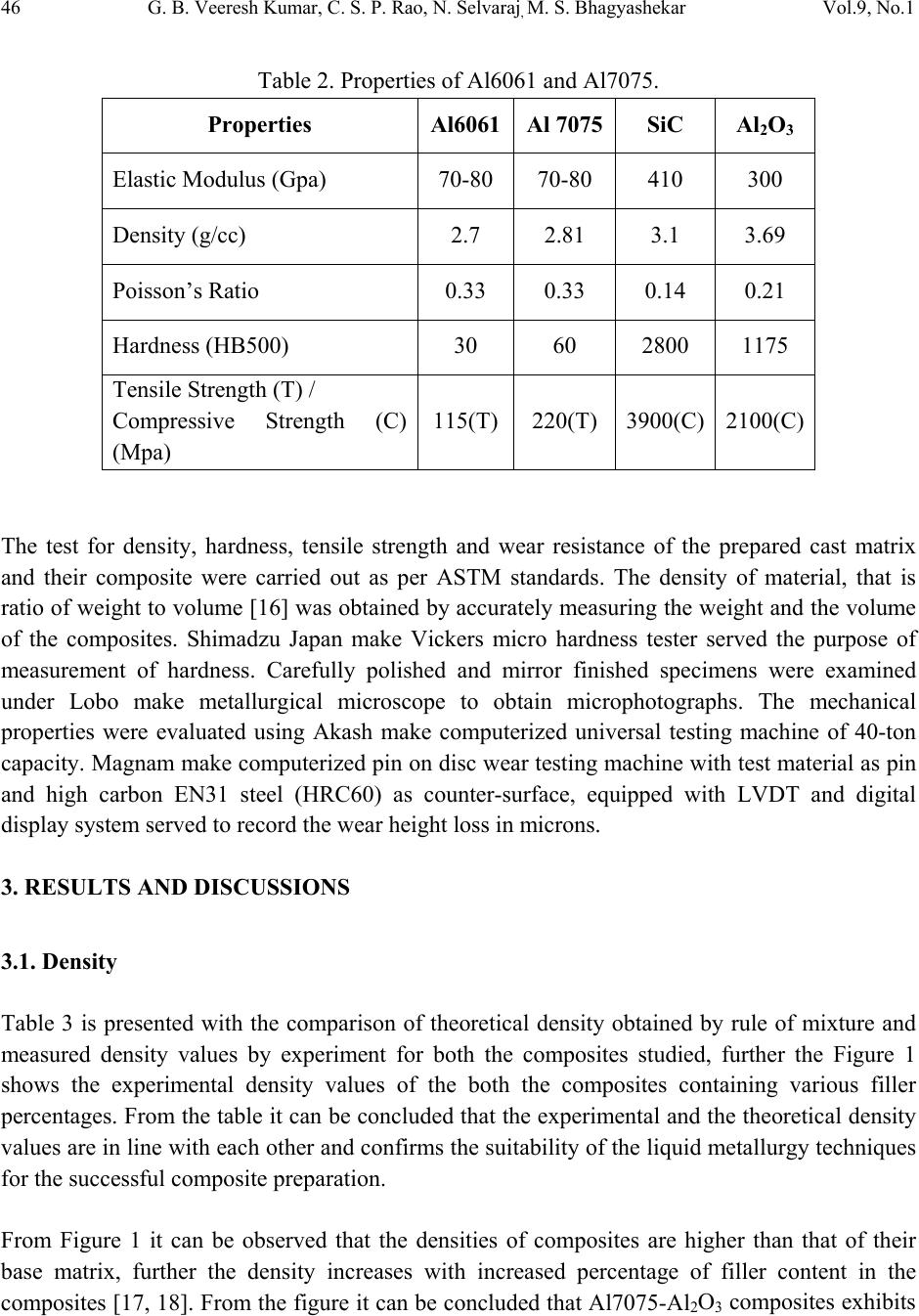 46 G. B. Veeresh Kumar, C. S. P. Rao, N. Selvaraj, M. S. Bhagyashekar Vol.9, No.1 Table 2. Properties of Al6061 and Al7075. Properties Al6061 Al 7075 SiC Al2O3 Elastic Modulus (Gpa) 70-80 70-80 410 300 Density (g/cc) 2.7 2.81 3.1 3.69 Poisson’s Ratio 0.33 0.33 0.14 0.21 Hardness (HB500) 30 60 2800 1175 Tensile Strength (T) / Compressive Strength (C) (Mpa) 115(T) 220(T) 3900(C) 2100(C) The test for density, hardness, tensile strength and wear resistance of the prepared cast matrix and their composite were carried out as per ASTM standards. The density of material, that is ratio of weight to volume [16] was obtained by accurately measuring the weight and the volume of the composites. Shimadzu Japan make Vickers micro hardness tester served the purpose of measurement of hardness. Carefully polished and mirror finished specimens were examined under Lobo make metallurgical microscope to obtain microphotographs. The mechanical properties were evaluated using Akash make computerized universal testing machine of 40-ton capacity. Magnam make computerized pin on disc wear testing machine with test material as pin and high carbon EN31 steel (HRC60) as counter-surface, equipped with LVDT and digital display system served to record the wear height loss in microns. 3. RESULTS AND DISCUSSIONS 3.1. Density Table 3 is presented with the comparison of theoretical density obtained by rule of mixture and measured density values by experiment for both the composites studied, further the Figure 1 shows the experimental density values of the both the composites containing various filler percentages. From the table it can be concluded that the experimental and the theoretical density values are in line with each other and confirms the suitability of the liquid metallurgy techniques for the successful composite preparation. From Figure 1 it can be observed that the densities of composites are higher than that of their base matrix, further the density increases with increased percentage of filler content in the composites [17, 18]. From the figure it can be concluded that Al7075-Al2O3 composites exhibits 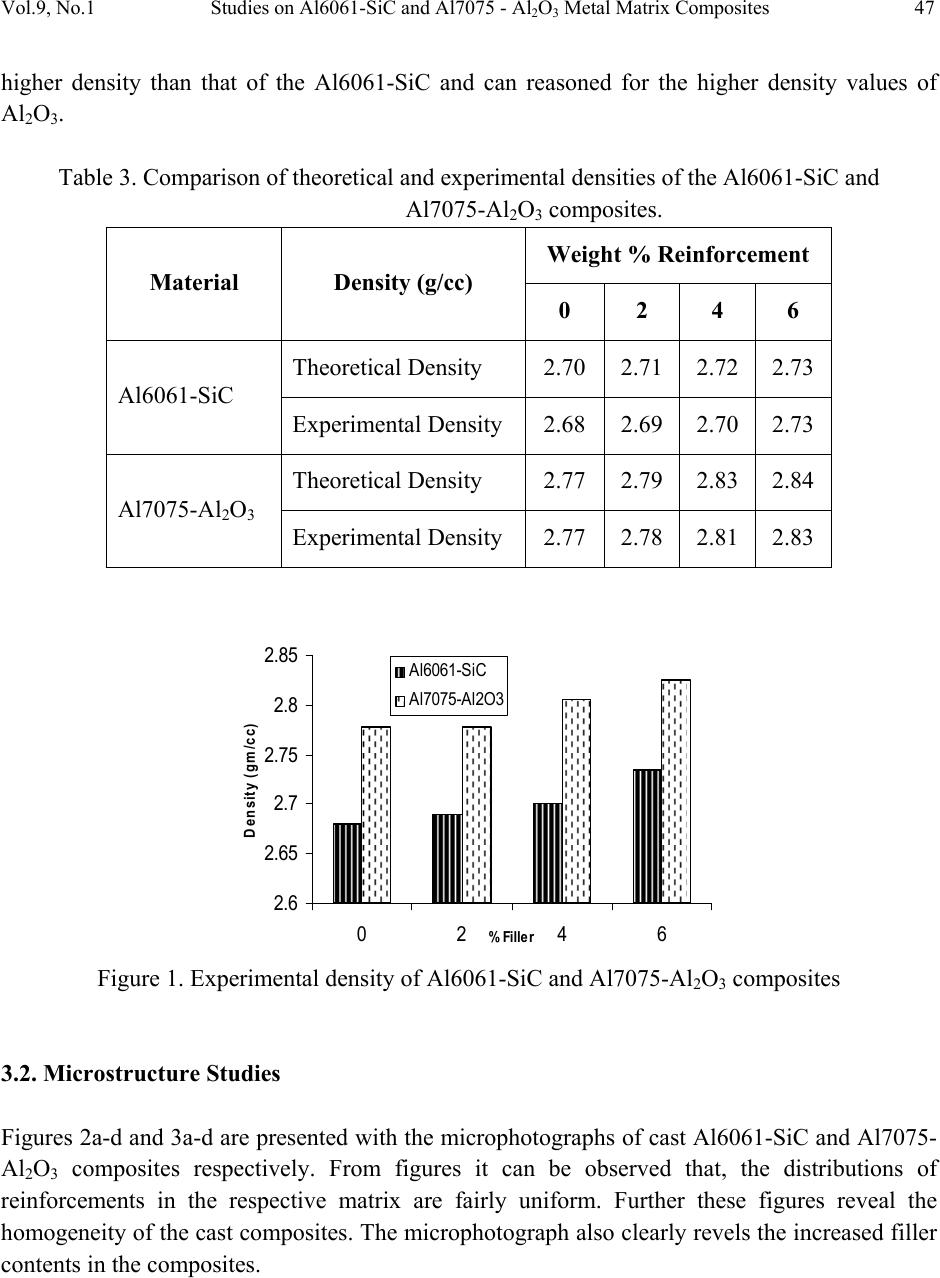 Vol.9, No.1 Studies on Al6061-SiC and Al7075 - Al2O3 Metal Matrix Composites 47 higher density than that of the Al6061-SiC and can reasoned for the higher density values of Al2O3. Table 3. Comparison of theoretical and experimental densities of the Al6061-SiC and Al7075-Al2O3 composites. Material Density (g/cc) Weight % Reinforcement 0 2 4 6 Al6061-SiC Theoretical Density 2.70 2.71 2.72 2.73 Experimental Density 2.68 2.69 2.70 2.73 Al7075-Al2O3 Theoretical Density 2.77 2.79 2.83 2.84 Experimental Density 2.77 2.78 2.81 2.83 2.6 2.65 2.7 2.75 2.8 2.85 0246 % Filler D en sity (g m/cc) Al6061-SiC Al7075-Al2O3 Figure 1. Experimental density of Al6061-SiC and Al7075-Al2O3 composites 3.2. Microstructure Studies Figures 2a-d and 3a-d are presented with the microphotographs of cast Al6061-SiC and Al7075- Al2O3 composites respectively. From figures it can be observed that, the distributions of reinforcements in the respective matrix are fairly uniform. Further these figures reveal the homogeneity of the cast composites. The microphotograph also clearly revels the increased filler contents in the composites. 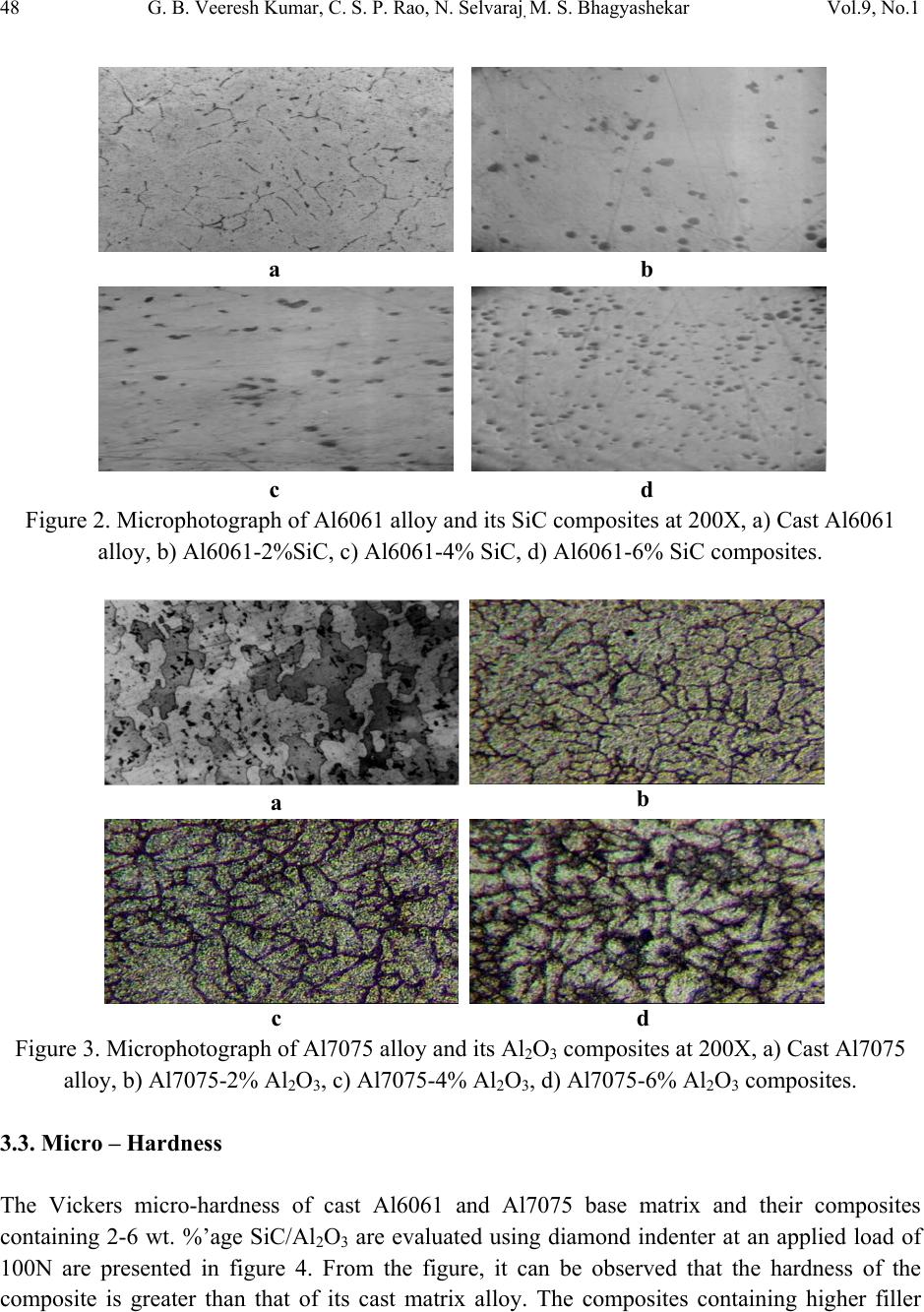 48 G. B. Veeresh Kumar, C. S. P. Rao, N. Selvaraj, M. S. Bhagyashekar Vol.9, No.1 a b c d Figure 2. Microphotograph of Al6061 alloy and its SiC composites at 200X, a) Cast Al6061 alloy, b) Al6061-2%SiC, c) Al6061-4% SiC, d) Al6061-6% SiC composites. a b c d Figure 3. Microphotograph of Al7075 alloy and its Al2O3 composites at 200X, a) Cast Al7075 alloy, b) Al7075-2% Al2O3, c) Al7075-4% Al2O3, d) Al7075-6% Al2O3 composites. 3.3. Micro – Hardness The Vickers micro-hardness of cast Al6061 and Al7075 base matrix and their composites containing 2-6 wt. %’age SiC/Al2O3 are evaluated using diamond indenter at an applied load of 100N are presented in figure 4. From the figure, it can be observed that the hardness of the composite is greater than that of its cast matrix alloy. The composites containing higher filler 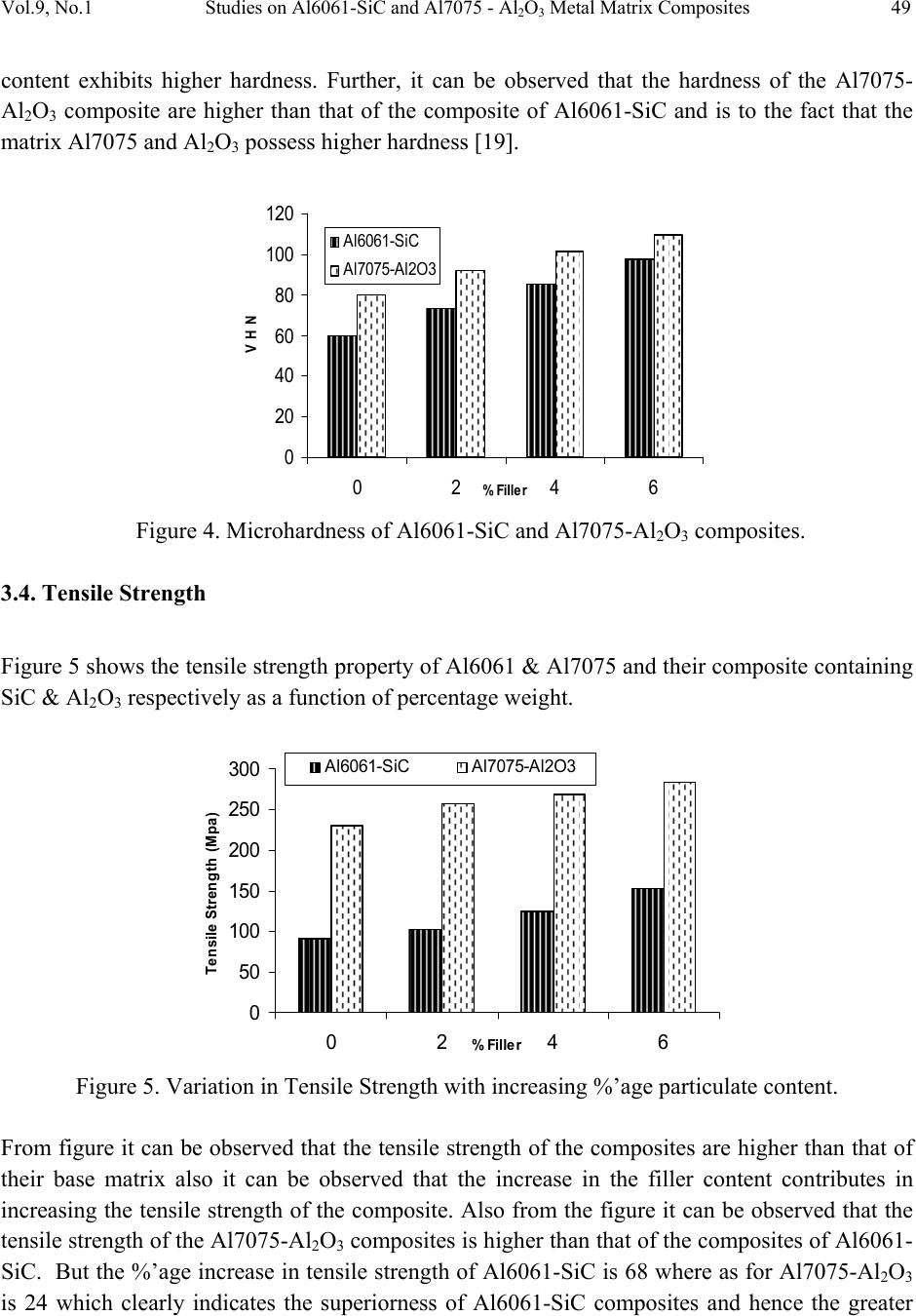 Vol.9, No.1 Studies on Al6061-SiC and Al7075 - Al2O3 Metal Matrix Composites 49 content exhibits higher hardness. Further, it can be observed that the hardness of the Al7075- Al2O3 composite are higher than that of the composite of Al6061-SiC and is to the fact that the matrix Al7075 and Al2O3 possess higher hardness [19]. 0 20 40 60 80 100 120 0246 % Filler V H N Al6061-SiC Al7075-Al2O3 Figure 4. Microhardness of Al6061-SiC and Al7075-Al2O3 composites. 3.4. Tensile Strengt h Figure 5 shows the tensile strength property of Al6061 & Al7075 and their composite containing SiC & Al2O3 respectively as a function of percentage weight. 0 50 100 150 200 250 300 0246 % Filler Tensile Strength (Mpa) Al6061-SiC Al7075-Al2O3 Figure 5. Variation in Tensile Strength with increasing %’age particulate content. From figure it can be observed that the tensile strength of the composites are higher than that of their base matrix also it can be observed that the increase in the filler content contributes in increasing the tensile strength of the composite. Also from the figure it can be observed that the tensile strength of the Al7075-Al2O3 composites is higher than that of the composites of Al6061- SiC. But the %’age increase in tensile strength of Al6061-SiC is 68 where as for Al7075-Al2O3 is 24 which clearly indicates the superiorness of Al6061-SiC composites and hence the greater  50 G. B. Veeresh Kumar, C. S. P. Rao, N. Selvaraj, M. S. Bhagyashekar Vol.9, No.1 contributions of SiC with regards to the increased tensile strength of its composites. 3.5. Tribological Properties The wear factor, defined as the ratio of wear volume (in mm3) to the product of applied load (in N) and sliding distance (in meter), is an important parameter, which quantifies the wear resistance (wear factor). Thus the wear factors of the material studied are presented. Figure 6a-c and figure 7a-c shows the wear factor for Al6061 and its composites containing SiC under an applied load of 10N and various sliding speeds and under the sliding speed of 100rpm and various applied loads respectively. Similarly figures 8a-c and 9a-c show the wear factor for Al7075 and its composites containing Al2O3. (a) (b) (c) Figure 6. Variation of Wear Factor at different RPM for Al6061 - SiC composites, under applied load of 10N and at a speed of (a) 100 rpm, (b) 300 rpm & (c) 500 rpm. 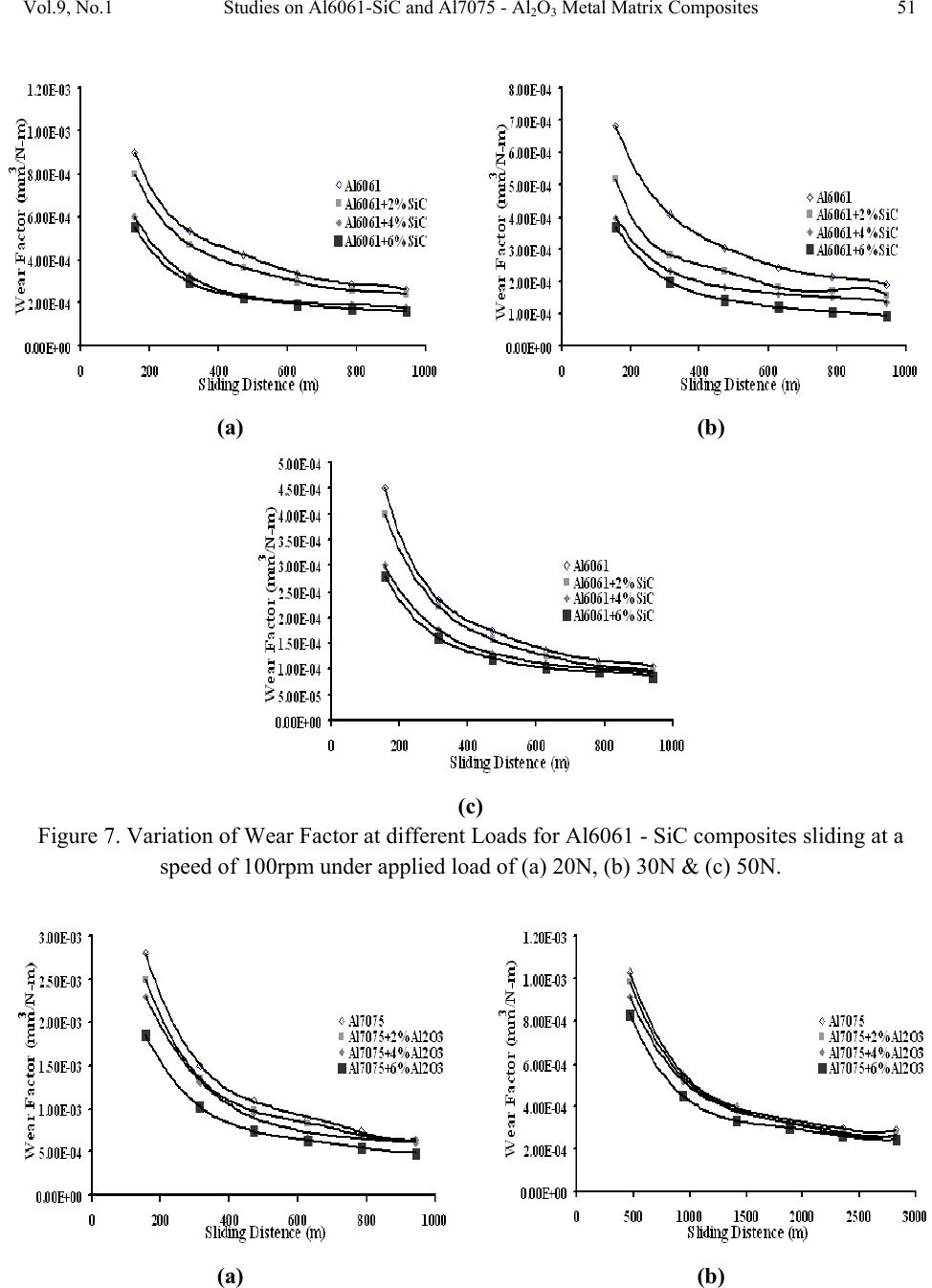 Vol.9, No.1 Studies on Al6061-SiC and Al7075 - Al2O3 Metal Matrix Composites 51 (a) (b) (c) Figure 7. Variation of Wear Factor at different Loads for Al6061 - SiC composites sliding at a speed of 100rpm under applied load of (a) 20N, (b) 30N & (c) 50N. (a) (b) 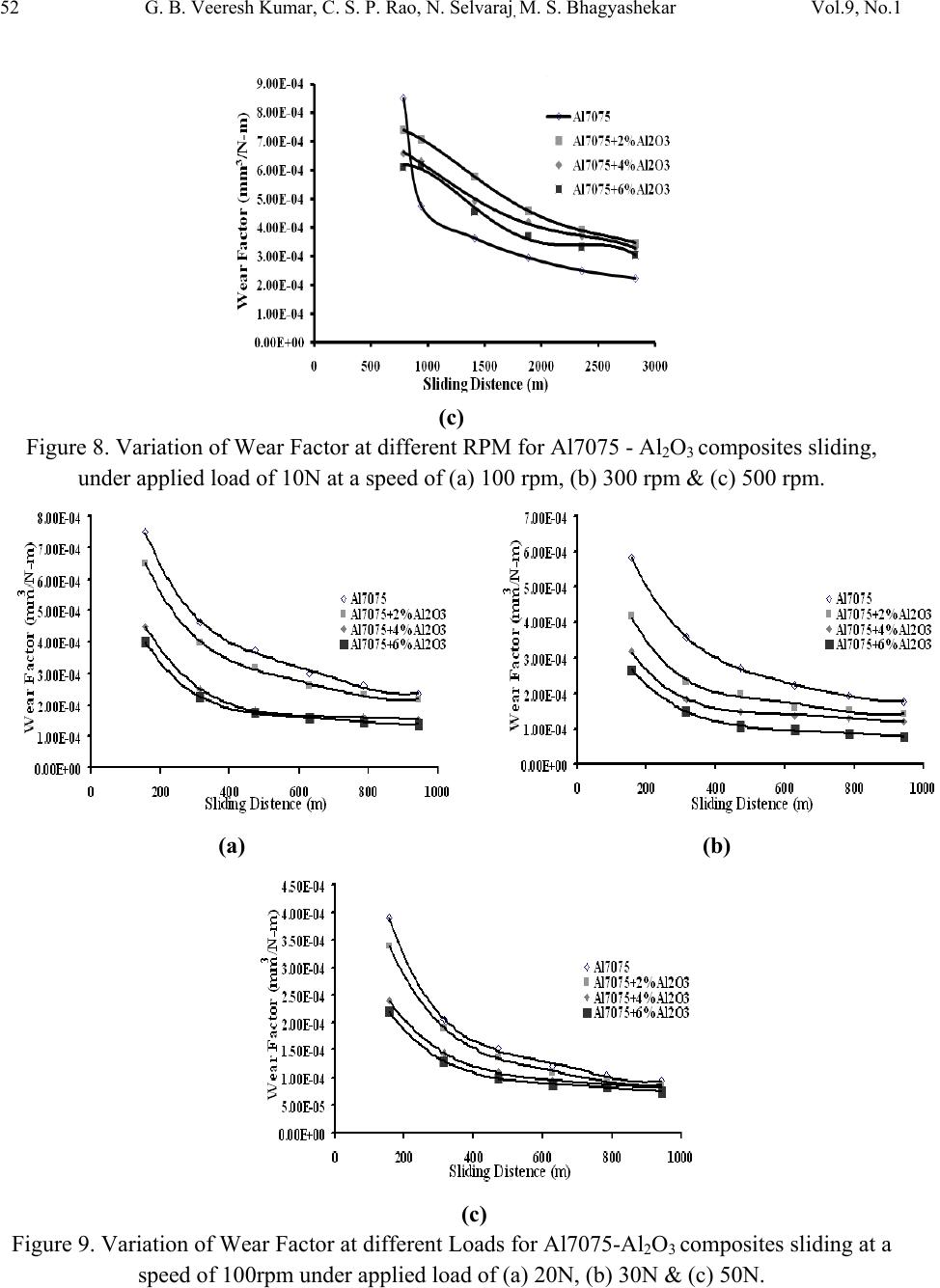 52 G. B. Veeresh Kumar, C. S. P. Rao, N. Selvaraj, M. S. Bhagyashekar Vol.9, No.1 (c) Figure 8. Variation of Wear Factor at different RPM for Al7075 - Al2O3 composites sliding, under applied load of 10N at a speed of (a) 100 rpm, (b) 300 rpm & (c) 500 rpm. (a) (b) (c) Figure 9. Variation of Wear Factor at different Loads for Al7075-Al2O3 composites sliding at a speed of 100rpm under applied load of (a) 20N, (b) 30N & (c) 50N. 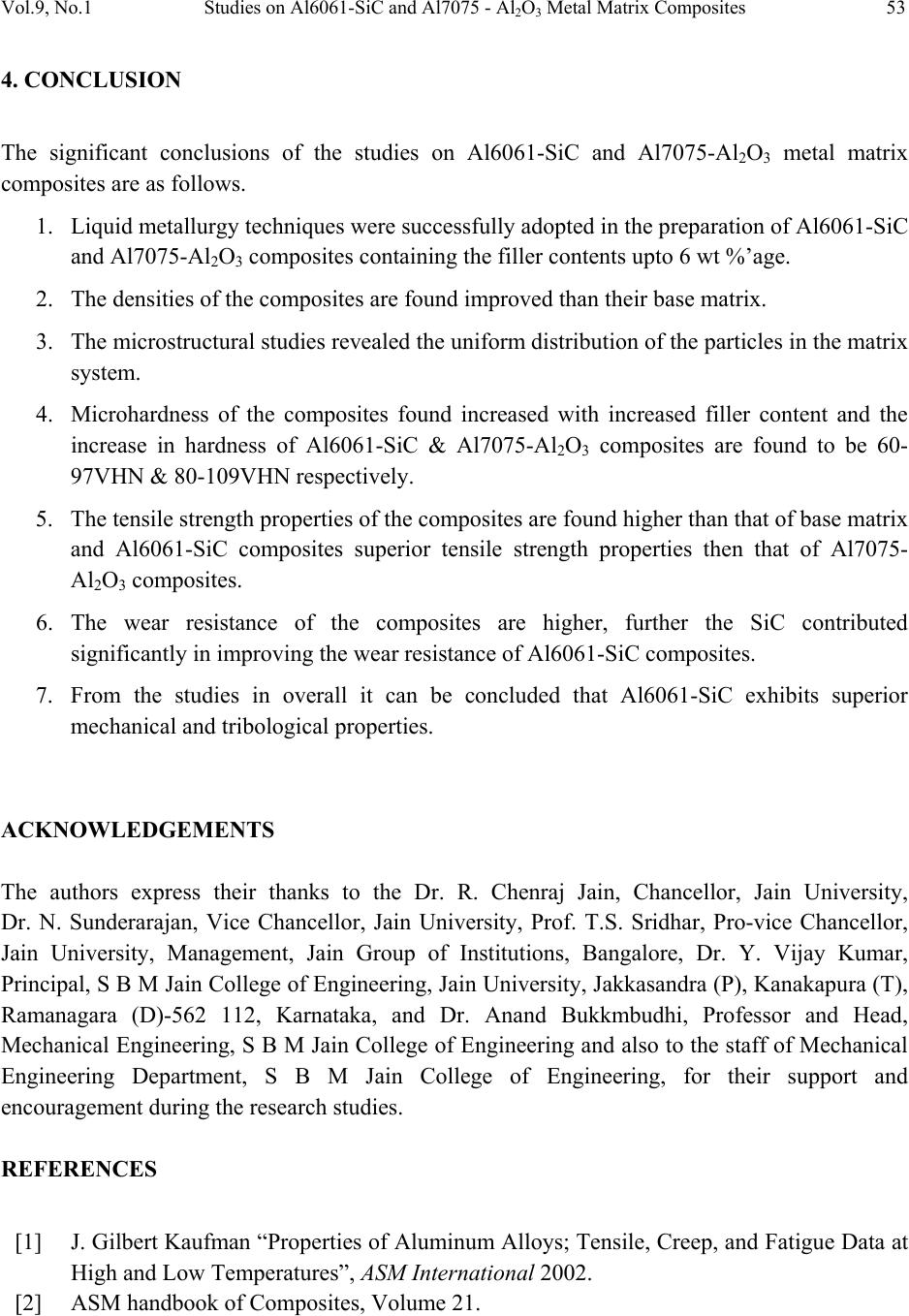 Vol.9, No.1 Studies on Al6061-SiC and Al7075 - Al2O3 Metal Matrix Composites 53 4. CONCLUSION The significant conclusions of the studies on Al6061-SiC and Al7075-Al2O3 metal matrix composites are as follows. 1. Liquid metallurgy techniques were successfully adopted in the preparation of Al6061-SiC and Al7075-Al2O3 composites containing the filler contents upto 6 wt %’age. 2. The densities of the composites are found improved than their base matrix. 3. The microstructural studies revealed the uniform distribution of the particles in the matrix system. 4. Microhardness of the composites found increased with increased filler content and the increase in hardness of Al6061-SiC & Al7075-Al2O3 composites are found to be 60- 97VHN & 80-109VHN respectively. 5. The tensile strength properties of the composites are found higher than that of base matrix and Al6061-SiC composites superior tensile strength properties then that of Al7075- Al2O3 composites. 6. The wear resistance of the composites are higher, further the SiC contributed significantly in improving the wear resistance of Al6061-SiC composites. 7. From the studies in overall it can be concluded that Al6061-SiC exhibits superior mechanical and tribological properties. ACKNOWLEDGEMENTS The authors express their thanks to the Dr. R. Chenraj Jain, Chancellor, Jain University, Dr. N. Sunderarajan, Vice Chancellor, Jain University, Prof. T.S. Sridhar, Pro-vice Chancellor, Jain University, Management, Jain Group of Institutions, Bangalore, Dr. Y. Vijay Kumar, Principal, S B M Jain College of Engineering, Jain University, Jakkasandra (P), Kanakapura (T), Ramanagara (D)-562 112, Karnataka, and Dr. Anand Bukkmbudhi, Professor and Head, Mechanical Engineering, S B M Jain College of Engineering and also to the staff of Mechanical Engineering Department, S B M Jain College of Engineering, for their support and encouragement during the research studies. REFERENCES [1] J. Gilbert Kaufman “Properties of Aluminum Alloys; Tensile, Creep, and Fatigue Data at High and Low Temperatures”, ASM Internationa l 2002. [2] ASM handbook of Composites, Volume 21. 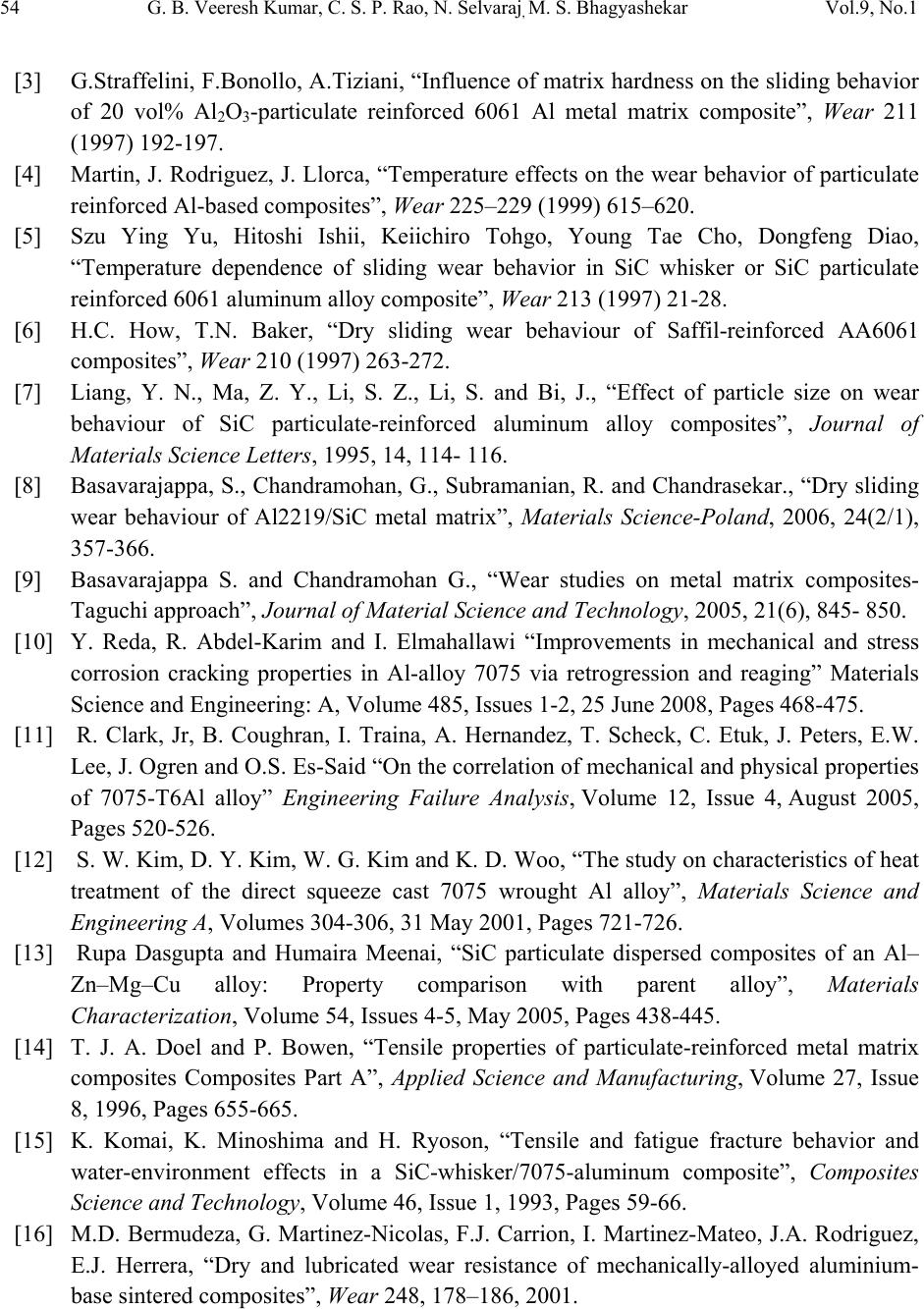 54 G. B. Veeresh Kumar, C. S. P. Rao, N. Selvaraj, M. S. Bhagyashekar Vol.9, No.1 [3] G.Straffelini, F.Bonollo, A.Tiziani, “Influence of matrix hardness on the sliding behavior of 20 vol% Al2O3-particulate reinforced 6061 Al metal matrix composite”, Wear 211 (1997) 192-197. [4] Martin, J. Rodriguez, J. Llorca, “Temperature effects on the wear behavior of particulate reinforced Al-based composites”, Wear 225–229 (1999) 615–620. [5] Szu Ying Yu, Hitoshi Ishii, Keiichiro Tohgo, Young Tae Cho, Dongfeng Diao, “Temperature dependence of sliding wear behavior in SiC whisker or SiC particulate reinforced 6061 aluminum alloy composite”, Wear 213 (1997) 21-28. [6] H.C. How, T.N. Baker, “Dry sliding wear behaviour of Saffil-reinforced AA6061 composites”, Wear 210 (1997) 263-272. [7] Liang, Y. N., Ma, Z. Y., Li, S. Z., Li, S. and Bi, J., “Effect of particle size on wear behaviour of SiC particulate-reinforced aluminum alloy composites”, Journal of Materials Science Letters, 1995, 14, 114- 116. [8] Basavarajappa, S., Chandramohan, G., Subramanian, R. and Chandrasekar., “Dry sliding wear behaviour of Al2219/SiC metal matrix”, Materials Science-Poland, 2006, 24(2/1), 357-366. [9] Basavarajappa S. and Chandramohan G., “Wear studies on metal matrix composites- Taguchi approach”, Journal of Material Science and Technology, 2005, 21(6), 845- 850. [10] Y. Reda, R. Abdel-Karim and I. Elmahallawi “Improvements in mechanical and stress corrosion cracking properties in Al-alloy 7075 via retrogression and reaging” Materials Science and Engineering: A, Volume 485, Issues 1-2, 25 June 2008, Pages 468-475. [11] R. Clark, Jr, B. Coughran, I. Traina, A. Hernandez, T. Scheck, C. Etuk, J. Peters, E.W. Lee, J. Ogren and O.S. Es-Said “On the correlation of mechanical and physical properties of 7075-T6Al alloy” Engineering Failure Analysis, Volume 12, Issue 4, August 2005, Pages 520-526. [12] S. W. Kim, D. Y. Kim, W. G. Kim and K. D. Woo, “The study on characteristics of heat treatment of the direct squeeze cast 7075 wrought Al alloy”, Materials Science and Engineering A, Volumes 304-306, 31 May 2001, Pages 721-726. [13] Rupa Dasgupta and Humaira Meenai, “SiC particulate dispersed composites of an Al– Zn–Mg–Cu alloy: Property comparison with parent alloy”, Materials Characterization, Volume 54, Issues 4-5, May 2005, Pages 438-445. [14] T. J. A. Doel and P. Bowen, “Tensile properties of particulate-reinforced metal matrix composites Composites Part A”, Applied Science and Manufacturing, Volume 27, Issue 8, 1996, Pages 655-665. [15] K. Komai, K. Minoshima and H. Ryoson, “Tensile and fatigue fracture behavior and water-environment effects in a SiC-whisker/7075-aluminum composite”, Composites Science and Technology, Volume 46, Issue 1, 1993, Pages 59-66. [16] M.D. Bermudeza, G. Martinez-Nicolas, F.J. Carrion, I. Martinez-Mateo, J.A. Rodriguez, E.J. Herrera, “Dry and lubricated wear resistance of mechanically-alloyed aluminium- base sintered composites”, Wear 248, 178–186, 2001.  Vol.9, No.1 Studies on Al6061-SiC and Al7075 - Al2O3 Metal Matrix Composites 55 [17] M.R. Rosenberger, C.E. Schvezov, E. Forlerer, “Wear of different aluminum matrix composites under conditions that generate a mechanically mixed layer”, Wear 259, 590– 601, 2005. [18] L.J. Yang “A test methodology for the determination of wear coefficient” Wear 259, 1453–1461, 2005. [19] J.M. Wu, Z.Z. Li, “Contributions of the particulate reinforcement to dry sliding wear resistance of rapidly solidified Al-Ti alloys”, Wear 244, 147–153, 2000. |

